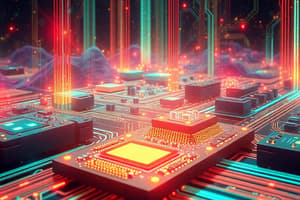Podcast
Questions and Answers
What is a solid-state device?
What is a solid-state device?
An electronic device in which electricity flows through solid semiconductor crystals rather than through vacuum tubes.
What types of semiconductors are there?
What types of semiconductors are there?
- Diode
- Transistor
- Thyristor
- All of the above (correct)
What is a semiconductor?
What is a semiconductor?
A substance that can only conduct electricity in certain environments such as when heated, light is applied, or in the presence of an electric field.
What types of semiconductor materials are there?
What types of semiconductor materials are there?
What is voltage rectification?
What is voltage rectification?
What is an intrinsic semiconductor?
What is an intrinsic semiconductor?
How is the n-pole created?
How is the n-pole created?
How is the p-pole created?
How is the p-pole created?
What is the difference between n-type and p-type semiconductors?
What is the difference between n-type and p-type semiconductors?
How do holes move?
How do holes move?
What is a diode?
What is a diode?
What are majority carriers?
What are majority carriers?
What is a minority carrier?
What is a minority carrier?
How do you increase the flow of minority carriers?
How do you increase the flow of minority carriers?
How is a forward biased P-N junction formed?
How is a forward biased P-N junction formed?
What happens in a forward biased P-N junction?
What happens in a forward biased P-N junction?
How is a reverse biased P-N junction formed?
How is a reverse biased P-N junction formed?
What is breakdown voltage?
What is breakdown voltage?
What is a thyristor?
What is a thyristor?
What is a triac?
What is a triac?
When are solid-state diodes used?
When are solid-state diodes used?
When are transistors used?
When are transistors used?
When are thyristors/triacs used?
When are thyristors/triacs used?
Microprocessors have ______ ________________.
Microprocessors have ______ ________________.
Flashcards are hidden until you start studying
Study Notes
Solid-State Devices Overview
- Solid-state devices utilize solid semiconductor crystals for electric current flow, contrasting with vacuum tubes.
- Semiconductor types include diodes, transistors, and thyristors.
Semiconductors
- Semiconductors conduct electricity under specific conditions (temperature, light, electric field) due to their small energy gap.
- Two primary semiconductor materials exist: n-type (negatively charged) and p-type (positively charged).
Voltage Rectification
- Rectification converts AC power into DC, essential for devices like x-ray tubes. Silicon diodes are used for this conversion.
Intrinsic and Extrinsic Semiconductors
- Intrinsic semiconductors (pure silicon) lack free electrons, while extrinsic semiconductors gain conductivity through added impurities.
- N-pole is formed by adding elements like arsenic or phosphorus; p-pole is created with elements like aluminum or boron.
P-N Junction
- A p-n junction forms by joining n-type and p-type materials, resulting in the attraction of holes and electrons, creating a depletion region.
- This junction acts as a potential barrier preventing flow of majority carriers while allowing minority carriers to cross.
Biasing P-N Junctions
- Forward bias occurs when p-type is connected to positive voltage, allowing current flow.
- Reverse bias applies positive voltage to n-type, preventing current flow except for very low reverse current.
Transistors
- Transistors consist of alternating n-type and p-type layers (NPN or PNP) and are categorized by their biasing behavior.
- In NPN transistors, base-emitter junction forms forward bias, creating current flow, while base-collector junction remains reverse biased until stimulated.
Field-Effect Transistors (FETs)
- FETs control current flow through a semiconductor using an electric field, structured with a conducting channel and a gate.
- Variants include junction field-effect transistor (JFET) and metal oxide semiconductor field effect transistor (MOSFET).
Thyristors and Triacs
- Thyristors are silicon-controlled rectifiers with four layers that act as electronic switches; they can trigger conduction under a specific gate signal.
- Triacs, capable of switching with either polarity, allow for bidirectional current flow in AC applications.
Applications of Solid-State Devices
- Solid-state diodes are primarily used for rectifying AC to DC supplies.
- Transistors serve in electronic timing circuits and safety interlocks.
- Thyristors and triacs are employed in the primary switching of x-ray exposures, controlling high-power applications.
- Logic circuits monitor function sequences before operations like x-ray exposure.
- Microprocessors find diverse applications across various electronic systems.
Studying That Suits You
Use AI to generate personalized quizzes and flashcards to suit your learning preferences.




